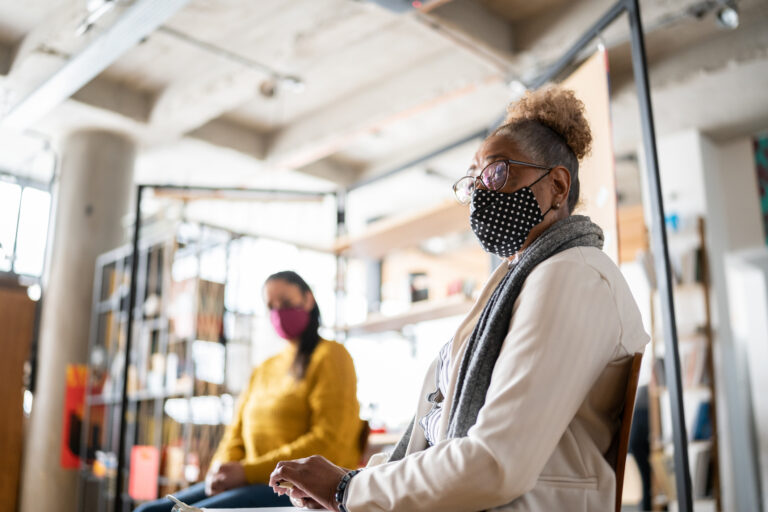New evidence is emerging about the long-term impacts of the COVID-19 pandemic in Los Angeles County, as shown in a recent study in PLOS ONE. Scientists from the University of Southern California and the Los Angeles County Department of Public Health (DPH) found that existing disparities in mental health between white and non-white residents have been exacerbated.
The study measured data on major depression risk and mortality among adults using two surveys conducted in 2018 and spring 2021. Researchers considered monthly averages from March 2020 (when the first stay-at-home orders were issued) to mid-April 2021 (after the peak of the pandemic). Based on this data, counties were divided into three zones:
- Areas with high COVID-19 mortality rates across the Los Angeles metropolitan area, South Los Angeles County, and East Los Angeles County.
- Areas with low COVID-19 death rates include western Los Angeles County and the South Bay.
- Moderate COVID-19 mortality areas include San Gabriel, San Fernando and the Antelope Valley.
As perhaps expected, residents of areas with high COVID-19 mortality rates were more likely to face risk of depression than those in areas with moderate or low COVID-19 mortality rates. But when the researchers broke down survey respondents by race, they found clear differences: In hard-hit areas, there was a trend toward an overall increased risk of depression among non-white Los Angeles County residents — Asian, Black, Hispanic, and Native American — but not white residents.
In 2021, non-white respondents in areas with the highest COVID-19 death toll tended to be at higher risk of depression than their peers in areas with lower COVID-19 death rates.
Even in 2018, the risk of depression was higher for non-white residents of the Los Angeles Metropolitan Area, South Los Angeles, and East Los Angeles than for non-white residents of West Los Angeles and the South Bay. By 2021, the gap had widened. The effects the researchers documented persisted even after controlling for other factors.
“We suspected that the pandemic has hit non-whites harder than whites, and that the mental health impacts may be related to the circumstances in which they live,” said corresponding author Jonathan Lamb, PhD, MPH, assistant professor of research emergency medicine at the Keck School of Medicine of the University of Southern California. “People in multigenerational households may not have enough space to isolate from their families when COVID-19 hits. They may have worked in industries with few protections and little time off to get tested. This could drastically increase their stress and erode their ability to cope with the pandemic.”
Analyzing disparities in the pandemic’s threat to life and health
The study paints a contrasting picture of COVID-19’s impact on Los Angeles County communities: In each of the three zones, coronavirus death rates were more than twice as high among non-white residents as they were among white residents.
Other numbers highlighted a notable reversal: in 2018, white residents in three zones of Los Angeles County actually had a higher mortality rate compared to their nonwhite counterparts. Because most nonwhite residents of Los Angeles County are Hispanic, the root of this disparity may lie in a phenomenon known as the Latino paradox: Records dating back to the 1980s show that Latinos have had longer life expectancies and lower mortality rates compared to whites, but on average they faced socioeconomic factors and health risks that belied those advantages.
The study adds to evidence that the coronavirus has, at least temporarily, erased the Latino paradox.
“Post-COVID, non-white mortality rates are rising,” said lead author Dr. Neeraj Sood, a professor at USC’s Price School of Public Policy and director of the Covid Initiative at USC’s Schaefer Center for Health Policy and Economics. “There are huge disparities in the impact of Covid. Depending on who you are and where you live, your experience during the pandemic could be much worse.”
The 2021 survey is part of the Los Angeles Pandemic Surveillance Cohort Initiative, a collaboration between the University of Southern California Schaefer Center, the Department of Population and Public Health Sciences at the Keck School of Medicine, and the Los Angeles County Department of Public Health. Researchers asked 1,222 participants from across the county how often they had experienced depressed mood or a lack of pleasure from everyday activities in the past two weeks. The same assessments were done in the existing 2018 survey.
The researchers’ findings increase understanding of a previously little-studied topic: the pandemic’s long-term effects on mental health in Los Angeles County. What they learned may inform efforts to mitigate these challenges through programs such as the LA County Health Department’s Wellness Centers and Community Public Health Team efforts.
“These results raise awareness of the significant impact that living and working environments have on mental health, particularly in low-income Black and Latino communities,” said co-author William Nicholas, PhD, MPH, director of the Center for Health Impact Assessment at the Los Angeles County Department of Public Health. “It is important to recognize that improving mental health requires investments in efforts that address the social and economic conditions that impact all health outcomes.”
The research could also help target aid in future virus outbreaks.
“Similar pandemics are likely in the future, and our study provides an interesting test case for how we might adapt,” Lam said. “When considering how to allocate mental health resources, we should put more of them in the communities with the greatest need.”
About the Study
Other co-authors on the study are Ryan Lee, Daniel Soto and Jennifer Unger of the Keck School of Medicine, and Alex Ho of DPH.
This study was supported by the Peter G. Peterson Foundation, the Conrad N. Hilton Foundation, the USC Office of the President, DPH, the Centers for Disease Control and Prevention, the Keck School of Medicine of USC and the W. M. Keck Foundation.


